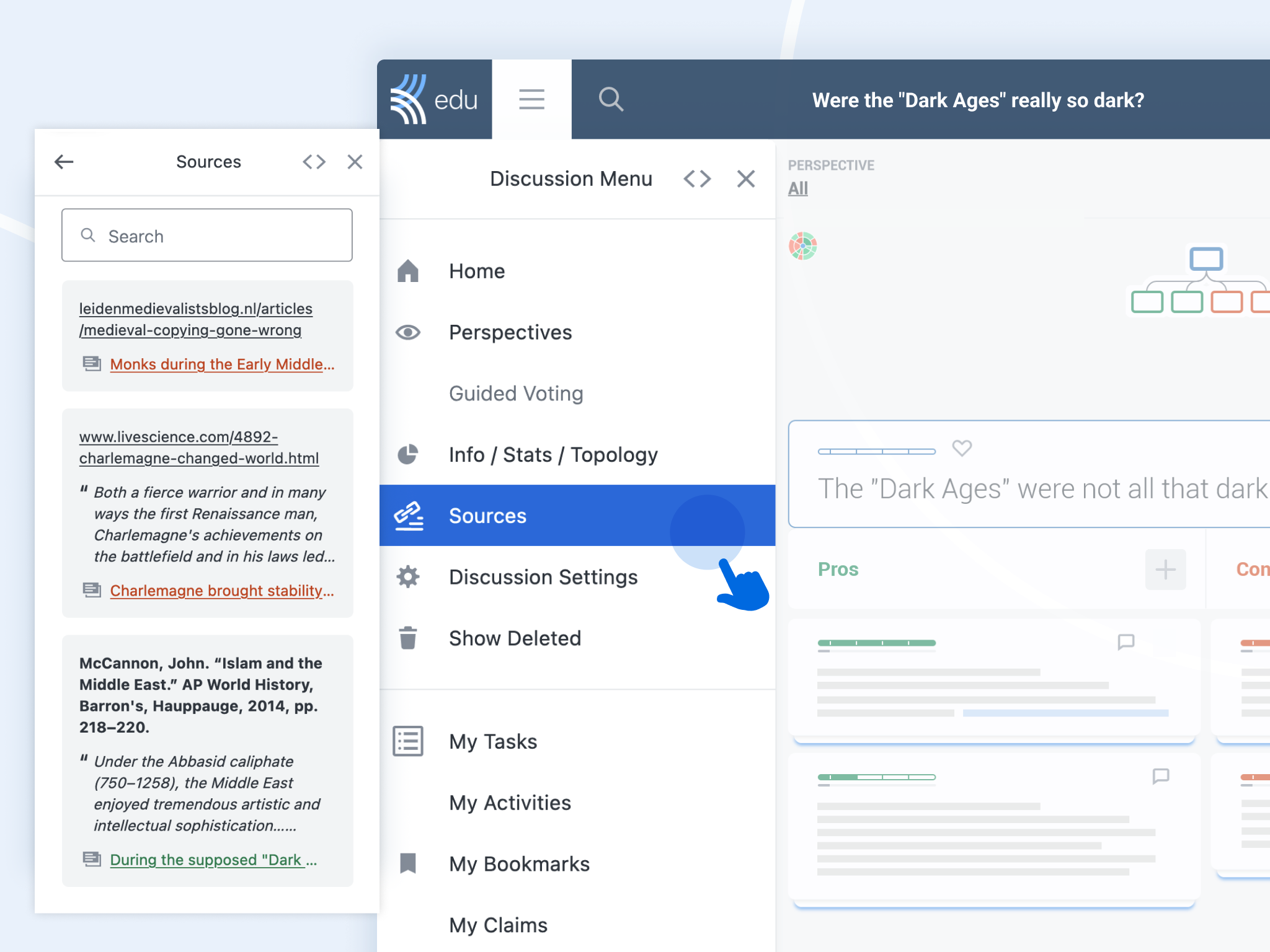When envisioning the qualities of a well-rounded student, you might picture them having strong social-emotional learning (SEL) skills such as empathy and respect for diverse perspectives. Students who possess these skills are invaluable in your classroom, as well as when they interact with more people in wider society. Therefore, it’s vital for educators to invest time in teaching students about different perspectives so they can thrive in our diverse world.
With this in mind, let’s explore the benefits in teaching students different perspectives and the classroom strategies for accomplishing this — including why it’s great to do so on Kialo Edu!
Why is it important to teach different perspectives to students?
Teaching students different perspectives helps them understand that others possess different thoughts, feelings, and viewpoints to their own, and that these viewpoints are often dependent on personal experiences. As students explore this concept, they learn the value of having and voicing diverse perspectives in order to build a thriving, democratic society.
Developing students’ awareness of different perspectives is particularly important in today’s digital world. When online, students are surrounded by filter bubbles and echo chambers that limit their exposure to diverse perspectives. This limitation narrows students’ understanding of complex issues and can lead to conflict when someone challenges their viewpoint.
Thus, educators should cultivate a classroom environment that maximizes opportunities for positive interaction with diverse perspectives to foster students’ SEL, communication, and critical thinking skills.
How does teaching different perspectives develop students’ SEL competencies?
Exploring different perspectives with students directly contributes to their development of the five core SEL competencies.
1. Teaching different perspectives improves self-awareness
When students learn to explain their own perspectives, they recognize that these are likely different from other people’s — and vice versa. While exploring different perspectives, students reflect on their own beliefs and biases, improving their self-awareness.
2. Teaching different perspectives improves self-management skills
As students become accustomed to having their peers challenge their viewpoints in discussions, they learn to manage their emotions effectively. This makes students better equipped to engage in constructive dialogue to find common ground between different perspectives.
Students gain an insight into other people’s lives through examining different perspectives, which encourages them to act with empathy. Learning how people’s experiences, backgrounds, and cultures shape their perspectives increases students’ social awareness and builds their respect for diversity.
4. Teaching different perspectives improves relationship skills
When students understand that others have different perspectives, they recognize the need to share their viewpoint respectfully. They learn to listen actively to others’ opinions and try to find common ground, helping to build stronger relationships.
5. Teaching different perspectives improves decision-making skills
Students who understand the value of different perspectives are able to draw on a wider range of insights when making decisions. They come to recognize the impact of their decisions on others, prompting them to make more responsible choices.
How does teaching students different perspectives develop their critical thinking skills?
Educators can create opportunities for students to practice critical thinking skills by exposing them to a wide range of perspectives in the classroom. Let’s examine three critical thinking skills that students can develop through learning about different perspectives.
1. Evaluate new perspectives through sources
Students learn the importance of keeping a healthy skepticism towards new perspectives that they may come across. Encourage them to check for bias and evaluate the strength of supporting evidence to establish the reliability of perspectives. By doing so, students learn that they must justify their own perspectives with evidence.
2. Analyze different perspectives to draw conclusions
Students sharpen their analysis skills by exploring diverse perspectives. They analyze the strengths and weaknesses of perspectives and identify common points and key differences. This deepens their topic comprehension and enables them to draw informed conclusions.
3. Problem-solve by using multiple perspectives
Students can use multiple perspectives to become better problem-solvers, analyzing problems from different angles to deepen their understanding. They learn to collaborate with their peers to generate a wider range of solutions, before evaluating the best option.
Strategies to teach different perspectives to students
For maximum impact, educators should weave opportunities for teaching different perspectives throughout lessons. Here are some cross-curricular strategies to try with students to increase their exposure to diverse perspectives.
1. Select materials that represent diverse perspectives
Educators should ensure that, wherever possible, their choice of stimulus materials represents a wide range of social, cultural, historical, or philosophical perspectives. Within lessons, students can analyze these diverse perspectives to gain an insight into people’s experiences and how these shape their perspectives. This will help students to challenge stereotypical viewpoints and avoid generalizations.
2. Use purposeful class discussions to explore perspectives

Educators can foster diverse perspectives with a classroom ethos that prizes healthy discussion and debate — the antithesis of online echo chambers.
Participating in regular discussions and debates can give students the confidence to share their perspectives with peers. Educators can then guide students in analyzing and respectfully challenging each other’s perspectives. This introduces the idea that perspectives are not fixed, encouraging students to adjust their viewpoints in light of new information.
3. Use case studies, scenarios, and sources to teach students to explore perspectives objectively
Case studies, scenarios, and primary and secondary sources are ideal for training students to engage objectively with multiple perspectives, something students may find challenging in personal situations.
Educators can help students identify and compare each perspective and guide them toward drawing impartial conclusions. Training these skills can enable students to reflect more objectively on their own perspectives.
4. Use collaborative tasks to teach students the value of multiple perspectives for problem-solving tasks
In collaborative problem-solving tasks, each student is likely to have a different perspective on the best approach. By teaching students how to integrate these different perspectives, educators can demonstrate the power of using multiple perspectives to solve a problem.
5. Encourage students to reflect on perspectives through journaling
In perspective journaling, students should note new perspectives they encountered during a lesson to identify any links to other perspectives. This helps them reflect on how new perspectives influence their existing viewpoint. Doing this regularly can help students internalize this reflective approach.
Advantages of using Kialo discussions to teach students different perspectives
The Kialo Edu Topic Library is bursting with curriculum-linked topics that are ideal for exploring different perspectives with students. Plus, the text-based format of Kialo discussions maximizes opportunities for students to interact with diverse perspectives.
In traditional discussions, students must take turns to share perspectives. But in Kialo discussions, all students can contribute their perspectives instantaneously and simultaneously.
And the text-based format provides a safe, inclusive space for all students to share their perspectives — not just the more outspoken students. The result is a potentially limitless stream of perspectives for students to explore!
Moreover, traditional discussions can quickly become one-sided. But in Kialo discussions, the branching argument-mapping structure displays arguments for and against a claim with equal prominence, prompting students to consider opposing ideas while drawing their attention to the potential limitations of their own viewpoint.
Finally, in traditional discussions, students can quickly run out of evidence to support their perspectives. But in Kialo discussions, justifying perspectives simply requires students to link each claim to a reliable supporting source. This teaches students that it’s possible to justify multiple perspectives.

By investing time in teaching different perspectives, you can develop your students’ SEL competencies and build their critical thinking skills, preparing them for a future of democratic engagement. You may even end up with a whole classroom full of well-rounded, emotionally mature, collaborative students!
We’d love to hear your perspective on teaching students different perspectives! Share them with us at feedback@kialo-edu.com or on social media.

